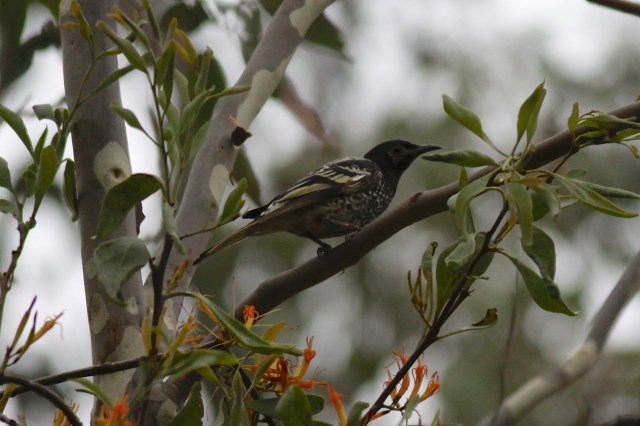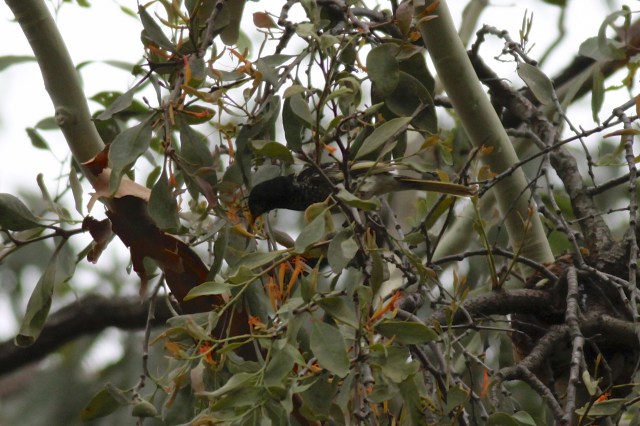Monthly Archives: February 2014
Highlands Fling
With the decision to make an earlier than expected return home to the UK, we modified our route back from the mallee to take in the Southern Highlands, south of Sydney, in an attempt to secure a few more Australia trip ticks, including hopefully another couple of ‘planet earth’ ticks. We arrived at Barren Grounds national park early, where it had rained over night. No sooner had we turned onto the entrance track when Dan said ‘stop’ – there on the grass in front of the rangers house was our first target, Pilotbird – a species I’d only seen briefly once before. So called because this species has a strong association with Superb Lyrebird and acts as a ‘pilot’ to it’s whereabouts – it looks not unlike a young European Robin. A short distance up the track, a small flock of Gang-Gang Cockatoos was a welcome addition to the list. Then on to the ‘main event’ of the morning, a search for Eastern Bristlebird – a species of very restricted range, on coastal heath, along the coast of New South Wales. Within 50 yards of the car park we’d heard and secured fabulous views of this, often secretive, species – a ‘lifer’ and another towards our trip target of 300. With reasonable views of another heathland species, Beautiful Firetail, we were ‘on a roll’, so decided to go in search of another potential ‘lifer’, Red-whiskered Bulbul – a species introduced in the suburbs of Sydney, back in the 1880’s. A drive around the streets of Port Kembla soon produced the goods and, to round things off, a brief stop at the cliff-top site of Hill 60 Park secured us Australasian Gannet and our final ‘tick’ of the trip, Kelp Gull -taking our overall trip total to over 300, including over 30 Australian ‘lifers’. Not a bad total for a family-oriented holiday and leaving me within striking distance of 500 for my Australia list!
Pilotbird – looking not unlike a juvenile European Robin
A welcome addition to the list – Gang-gang Cockatoo
Prime target of the visit to Barren Ground NP, the usually secretive Eastern Bristlebird
Not a great picture but nonetheless a real bonus – Beautiful Firetail
Red-whiskered Bulbul – an introduced species from Asia
And finally, Kelp Gull – last bird of a great morning’s birding, 300th for the trip and a fitting end to five weeks memorable birding in Australia
Wonders of a Mallee water-hole
The plan was to bring the Australian leg of our holiday to a close with a return trip to Mallee country – my third visit but a ‘first’ for Jane. We travelled through the upper Hunter, taking in the Goulburn River National Park, before making the 400k trek to Lake Cargelligo – gate way to Mallee country. With temperatures above 40 degrees and swarms of flies the birding was unusually difficult and our first evenings visit to this unique habitat was proving to be an energy and moral-sapping event – until that is we came across the water-hole! Over the course of the next 24 hours we had outstanding views of over thirty species of bush birds here, including most of the areas specialities. Here are some of the species using the water-hole or seen nearby:
First, Restless Flycatcher
Diamond Dove, a difficult species to catch up with
Male Black Honeyeater drinking, with Spiny-cheeked Honeyeater in the background
Crested Bellbird – more often heard than seen
Gilbert’s Whistler, a mallee speciality – here a male is drinking alongside a White-eared Honeyeater
A Mulga Parrot and Common Bronzewing – we saw more than thirty of both species
Speckled Warbler
A splendid male Red-capped Robin
Southern Scrub-robin – another mallee speciality
Splendid Fairy-wren
Brown Songlark
To finish, the common but curious Tawny Frogmouth


























